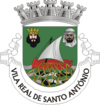Vila Real de Santo António
| Vila Real de Santo António | |||
|---|---|---|---|
| Municipality | |||

The main square
|
|||
|
|||
 |
|||
| Coordinates: 37°11′38″N 7°24′57″W / 37.19389°N 7.41583°WCoordinates: 37°11′38″N 7°24′57″W / 37.19389°N 7.41583°W | |||
| Country |
|
||
| Region | Algarve | ||
| Subregion | Algarve | ||
| Intermunic. comm. | Algarve | ||
| District | Faro | ||
| Parishes | 3 | ||
| Government | |||
| • President | Luís Filipe Soromenho Gomes (PPD-PSD) | ||
| Area | |||
| • Total | 61.25 km2 (23.65 sq mi) | ||
| Population (2011) | |||
| • Total | 19,156 | ||
| • Density | 310/km2 (810/sq mi) | ||
| Time zone | WET/WEST (UTC+0/+1) | ||
| Postal code | 8900 | ||
| Area code | 281 | ||
| Patron | Nossa Senhora da Encarnação | ||
| Website | http://www.cm-vrsa.pt | ||
Vila Real de Santo António is a city, civil parish, and municipality in the Algarve, Portugal. The population in 2011 was 19,156, in an area of 61.25 km². It is one of the few municipalities in Portugal without territorial continuity: its territory comprehends two parts, with the municipal seat located in the eastern part. Both the city and the municipality are the southeasternmost of Portugal. Vila Real de Santo António was founded after the 1755 Lisbon earthquake, and largely expanded in 1774 using the same architectural and construction techniques employed in the reconstruction of Lisbon after the disaster.
The city is situated next to the Guadiana river. Before the construction of the Guadiana International Bridge (in its neighboring upstream municipality of Castro Marim) it used to be the easiest access to Portugal from Andalusia (via ferry from the Spanish city of Ayamonte across the river). Nevertheless, international movement of people and goods is still intense and much visible in the city.
The history of settlement in the region pre-dates the Pombalinan community of the 18th century. The coastline area of Vila Real was inhabited by Megalithic tribes who constructed beehive tombs in the around Nora, near Cacela. The Romans, and much later the Arabs, made the settlement of Cacela an important village during their occupation of the territory, constructing fortifications to protect them from invading bands.
In 1240, Paio Peres Correia, master of the military Order of Santiago established Cacela as his point of departure for the reconquest of the Algarve, during the Reconquista. Small settlements were eventually established near the Cacela, including many medieval fishing villages, such as Santo António de Arenilha along the coast.
In the 17th century, the vila (town) of Santo António was an important frontier outpost, controlling commerce and developing the lucrative fishing grounds, there establishing canning and conservation industry. Vila Real de Santo António was a relatively recent community; the region was sparsely populated prior to its foundation and Cacela was the municipal seat of the existing municipality. For centuries, Castro Marim was the only large town guarding the border with Spain, and the settlements in the region were small and undefended. On 30 December 1773, during the reign of Joseph I, a royal decree ordering the creation of a new town at the tip of the Algarve. The impetus for this decision is unclear, but there was several justifications for enhancing the settlement of the region, which included: increasing the human presence near the Spanish border, to prevent any incursions; to better control duties charged on cross-border activity; to be better defend the region from a full-scale attack; or to provoke Spain with a modern settlement that was easily seen from Ayamonte; or to simply rebuild the nearby town fishing village of Santo António de Arenilha and resettle its population. Santo António de Arenilha was destroyed by the same tsunami that was triggered by the devastating 1755 Lisbon earthquake.
...
Wikipedia


